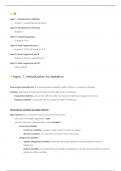Summary
Frequent Statistics Summary - Introductory Statistics with Randomization and Simulation (SOW-BKI138)
- Course
- Institution
Summary of Frequent Statistics (SOW-BKI138) course material, based on book "Introductory Statistics with Randomization and Simulation" by OpenIntro. This course is part of the AI bachelor curriculum, taught by Radboud University.
[Show more]



